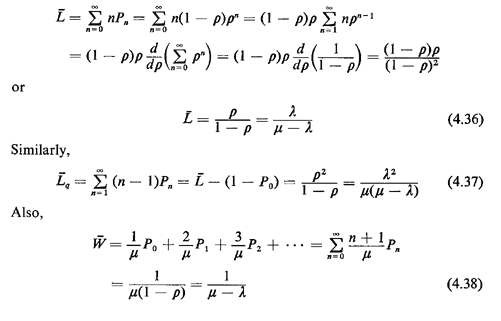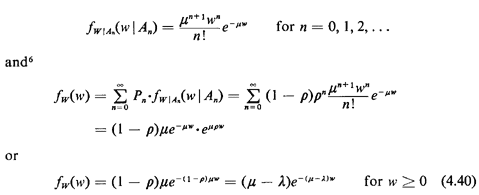4.6.1 Case 1 : One Operator, Infinite Number of Lines
Consider first a case in which a single operator answers all calls and in which the
number of telephone lines leading into the switchboard is large enough so that the system
never runs out of lines. If the operator is busy when a call arrives, the caller hears a
taped message to "please wait" and his or her call joins the queue of 0, 1, 2, .
. . more callers already waiting for the single operator. We assume that:
No caller ever gets sufficiently discouraged from waiting to hang up.
An electronic device sequences calls so that they are answered in a FCFS order.
The pdf for call interarrival times is negative exponential with mean 1/ and the pdf for
service times (duration of telephone conversations) is negative exponential with mean 1/ and the pdf for
service times (duration of telephone conversations) is negative exponential with mean 1/ . .
What has been described is a queueing system of the M/M/1 type with FCFS
service and an infinite system capacity. The latter is due to the large number of lines,
which theoretically are sufficient so that there is always an open line to the
switchboard. A state-transition diagram for this system is shown in Figure 4.6.

In terms of our fundamental model, we then have
 n
= n
=  for n = 0, 1, 2.... for n = 0, 1, 2....
 n = n =  for n = 1, 2,3,.... for n = 1, 2,3,....
and substituting into (4.28) and (4.30)-and recognizing the presence of a geometric
series for  (= (=  / / ) -- we find that ) -- we find that

with the condition for steady state being that the geometric series
converges, that is, that

The condition (4.35) makes sense intuitively. If  > 1 (i.e., if > 1 (i.e., if  > >  ), the
average rate of arrivals at the queueing system exceeds the rate at which the
server-operator can service calls. Thus, the longer the system operates, the longer the
queue tends to become and no steady state is ever reached. ), the
average rate of arrivals at the queueing system exceeds the rate at which the
server-operator can service calls. Thus, the longer the system operates, the longer the
queue tends to become and no steady state is ever reached.
It is much less obvious why steady state is not reached for  = 1. A possible way for explaining this is to
argue that the longer the queue grows in this case, the more unlikely it is that it will
ever appreciably decrease again, since the service rate just matches the arrival rate. = 1. A possible way for explaining this is to
argue that the longer the queue grows in this case, the more unlikely it is that it will
ever appreciably decrease again, since the service rate just matches the arrival rate.
Numerous other quantities can now be computed for the M/M/1 system. For
instance (the algebra here is quite interesting),

and

[Of course, (4.37)-(4.39) could have been obtained from (4.36) by just using (4.10),
(4.11), and (4.13).]
In addition to the expected total system time,  , it is actually possible to derive, for a M/M/1 queue, the pdf for
the system occupancy time, W, under steady-state conditions. To do this, let A. be the
event that a random call arrives to find n other calls already at the switchboard and thus
becomes the (n + 1)th call in the system. (Clearly, P{An} = Pn.) The
total time that caller spends in the system (in queue and in service) is the sum of n + 1
independent and negative exponentially distributed random variables each with mean l/ , it is actually possible to derive, for a M/M/1 queue, the pdf for
the system occupancy time, W, under steady-state conditions. To do this, let A. be the
event that a random call arrives to find n other calls already at the switchboard and thus
becomes the (n + 1)th call in the system. (Clearly, P{An} = Pn.) The
total time that caller spends in the system (in queue and in service) is the sum of n + 1
independent and negative exponentially distributed random variables each with mean l/ . .
[The remaining service time of the caller who occupies the operator at the time of
arrival of the caller of interest is also distributed as a negative exponential random
variable because of the "no-memory" property of the negative exponential pdf.]
Thus, W, for any given n, has the pdf of an Erlang random variable of
order n + 1. So, we have

Thus, somewhat surprisingly, the system occupancy time is exponentially distributed.
Its expected value,  , is
equal to [ , is
equal to [ (l - (l -  )]-1 which, of course, is the result
we have already obtained in (4.38). )]-1 which, of course, is the result
we have already obtained in (4.38).
In a quite similar way, one can derive the pdf for the time spent waiting
in the queue, Wq. This pdf is a mixed one, having an impulse at Wq =
0. The reason is that with probability P0 = 1 -  , the waiting time will be equal to 0. It is
thus more convenient to write the cumulative distribution for Wq: , the waiting time will be equal to 0. It is
thus more convenient to write the cumulative distribution for Wq:

Exercise 4.3 Show that the variance of the total number of callers
in the system is

Thus, as   1, not only
does the expected number of callers, 1, not only
does the expected number of callers,  , in the queueing system grow in proportion to (1- , in the queueing system grow in proportion to (1- )-1 but also the variance grows as
(1 - )-1 but also the variance grows as
(1 -  )-2 (i.e., even
faster). )-2 (i.e., even
faster).
Exercise 4.4 Finally, our last result refers to the average duration of a busy
period for the M/M/1 system. A busy period is defined to begin with the arrival of a call
while the system switchboard is completely empty and to end when the switchboard next
becomes free once again. Argue that in steady state,

5 The remaining service time of the caller who occupies the
operator at the time of arrival of the caller of interest is also distributed as a
negative exponential random variable because of the "no-memory" property of the
negative exponential pdf.
6 Remember that  . .
|